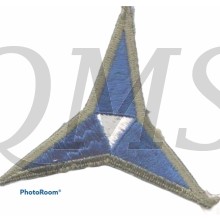Mouwembleem 3rd Corps (Sleeve patch 3rd Corps)
III Corps is a corps of the United States Army headquartered at Fort Hood, Texas. It is a major formation of the United States Army Forces Command.
Activated in World War I in France, III Corps oversaw US Army divisions as they repelled several major German offensives and led them into Germany. The corps was deactivated following the end of the war.
Reactivated in the interwar years, III Corps trained US Army formations for combat before and during World War II, before itself being deployed to the European Theater where it participated in several key engagements, including the Battle of the Bulge where it is known as the force that relieved the surrounded 101st Airborne Division.
Following the Japanese attack on Pearl Harbor signaling the entrance of the US into World War II, III Corps remained in the United States, where it was assigned to organize defenses of the West Coast, specifically California, from the threat of attack from Japan. During this time III Corps operated at Monterey, California.
The corps was moved to Fort McPherson, Georgia in early 1942 for training. After a short period, the corps returned to Monterey and on 19 August 1942, it was designated a separate corps, capable of deployment. During the next two years, III Corps would train thousands of troops for combat, including 33 division-sized units, and participate in four corps-level maneuvers, including the Louisiana Maneuvers.
Europe
On 23 August 1944, the corps headquarters departed California for Camp Myles Standish in Massachusetts. It deployed for the European Theater of Operations on 5 September 1944. Upon arrival at Cherbourg, France, the corps was assigned to the Ninth Army, Twelfth United States Army Group, and given the code name "CENTURY" which it retained throughout the war. The corps headquarters was established at Carteret, in Normandy, and for six weeks, the corps received and processed all the troops of the 12th Army Group arriving over the Normandy beachesduring that period. The corps also participated in the "Red Ball Express" by organizing 45 provisional truck companies to carry fuel and ammunition for the units on the front lines.
The corps was assigned to the Third United States Army on 10 October 1944, and moved to Etain, near Verdun, and into combat. The corps' first fighting was for the Metz region, as it was moved to attack Fort Jeanne d'Arc, one of the last forts holding out in the region. That fort fell on 13 December 1944.
Later that month on 16 December came the last German counteroffensive in the Battle of the Bulge, as over 250,000 German troops, supported by over 1,000 tanks and assault guns assaulted the lines of VIII Corps, some 40 miles to the north of III Corps. The next day, Third Army commander General George Patton warned III Corps that it would likely be ordered to assist. At that time the corps consisted of the 26th Infantry Division, 80th Infantry Division and the 4th Armored Division. III Corps was moved north to assist in the relief of Bastogne, with the attack commencing at 0400 on 22 December. The corps advanced north, catching the German forces by surprise on their south flank, cutting them off. The 4th Armored Division was eventually able to reach Bastogne, where the 101st Airborne Division had been surrounded by German forces, and relieve it. During the first 10 days of this action, III Corps liberated more than 100 towns, including Bastogne. This operation was key in halting the German offensive and the eventual drive to the Rhine River.
During the first four months of 1945, III Corps moved quickly to the offensive. On 25 February, the corps, now as part of the First United States Army, established a bridgehead over the Roer River, which, in turn, led to the capture of the Ludendorff Bridge at Remagen, on the Rhine River, on 7 March. On 30 March, the Edersee Dam was captured intact by Task Force Wolfe of the 7th Armored Division, and the corps continued the attack to seize the Ruhr Pocket on 5 April 1945. In late April, III Corps reformed and launched a drive through Bavaria towards Austria. On 2 May 1945, III Corps was ordered to halt at the Inn River on the Austrian border, just days before V-E Day, when the German forces surrendered, bringing an end to the war in Europe



